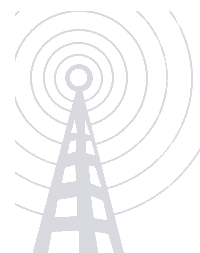
Can you hear me now?
Podcasting to create dynamic, multimedia learning environments
Shelly Drumm and Ruben Duran
michelle.drumm@hccs.edu | ruben.duran@hccs.edu

This presentation is licensed under a Creative Commons Attribution-Non Commercial-ShareAlike 2.5 License. Please use responsibly and often!
The plan
- Demystify
- Define
- Deconstruct
- Demonstrate
- Instructional applications
- Projects in progress (here and elsewhere)
- Nuts and Bolts
In February of 2005 , I did I talk at the faculty workshop about blogs and blogging. Meriam Webster had just named "blog" the word of the year for 2004. I just read that the word of the year for 2005 according to the New American Oxford Dictionary was Podcast. Which means I'm a little behind....
How many of you folks have heard of podcasting? How many of you know what it is? Most people have an understanding that podcasting has something to do with the iPod, which is to say something to do with audio and computers. What Ruben and I hope to do today is to demystify the term podcasting, explain how it works without getting too technical by breaking it down to its two most unique components. We want you to know how podcasts differ from other audio files. We'll discuss a few ways that podcasting can enrich your classes, highlight some podcasting projects going on here at Central, and then show you just how easy podcasting can be.
Demystify
- An example: Insta Spanish
- Debunk - podcasting does NOT require:
- iPod
- mp3 player
- Mac
First, let me show you guys an example of a podcast, and how it can be dropped into a couple of different places. (show insta spanish website - see that podcasts are there online - show how they can be fed directly into a webct classroom - students don't have to leave the safety of their own classroom, and updates are automatically sent in. also play podcast from ipod - stressing that when a new file is uploaded to the website, the next time I charge up my ipod, that will automatically be dropped to the ipod).
Before we move on, let me point out that the examples we looked at debunk a common misconception about podcasting. Podcasting does not require an iPod, or other portable Mp3 player, nor does it require anyone to be using a machintosh!
Define
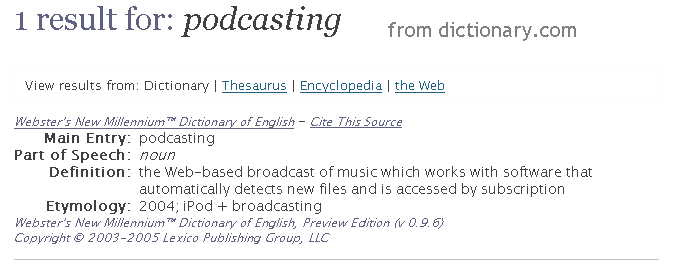
So what we're talking about is self-refreshing, portable audio content. That's what podcasting is about. Podcasting is a way of distributing multimedia files - audio and also video - on the Internet, and taking advantage of syndication technology to allow for automatic distribution to other webpages and portable audio devices.
Deconstruct
- Syndication (RSS)
- Portability
How many of you have played around with uploading audio files to webct before? It can be a great way to enhance a classroom - you can incorporate music, spoken lectures, etc. right? So what makes podcasting any different that? The differences can be broken down into two primary qualities: Syndication and Portability.
Syndication
- RSS
- Like radio distribution
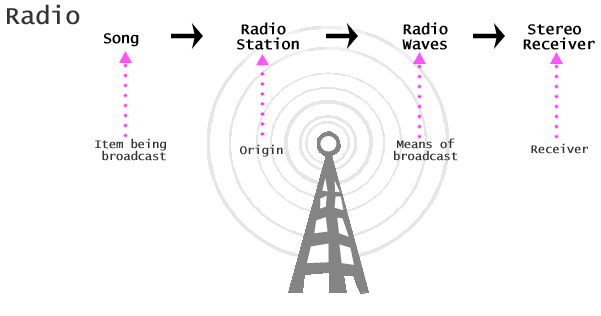
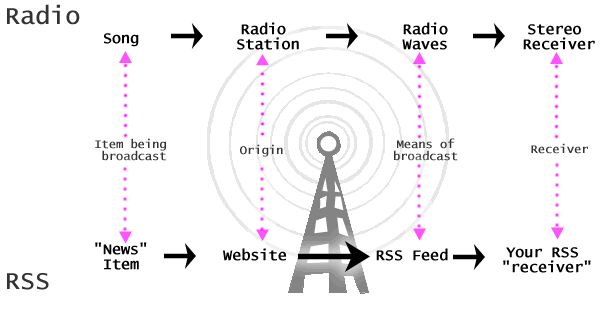
Syndication on the web is achieved primarily using a technology called RSS. I'm not going to get too techy on you, but the power of RSS is amazing enough to devote a few minutes talking about it.
Syndication online works much the same way it works in more traditional media. Using radio as an example, if a song is played once by a deejay in a radio station, we know that it gets broadcast out over a signal, and that all of our radio receivers pick it up and play it back. The same is true for websites that are RSS enabled - RSS is the technology that allows a site to grab and publish information from another site. What's changed between this and radio is that the song that's broadcast is now some web-based tidbit (text, audio, video), the point of origin is now a website instead of the radio station, the means of broadcast is now this RSS feed instead of radio waves, and now instead of a stereo acting as our receiver, you can configure your own receiver from any number of options. These receivers are commonly referred to as aggregators.
Examples of Syndication and Aggregation
- My Google homepage
- LibLine, in MyLife and WebCT
- Bloglines
Relation to Podcasting
Let me show you an example - this is my google homepage and portal sites like this or "my yahoo" or "my msn" are some of the most common ways people use RSS feeds - whether they know it or not. Let's take a look at what's going on in the left hand column. What you see there is a list of a few of my favorite information sources, with the current headlines displayed. Now, there isn't some guy at google whose job is to monitor my favorite news sources and update my personal page when things are added. Too bad! What's going on here is that each of these sites publish what is called an RSS feed, and whenever new content is added to those pages, that feed is updated to reflect that. My google homepage is set up as a receiver - like a radio receiver - and it tunes into that signal, and displays that information here on this page.
Another type of aggregator is something like Bloglines. Bloglines is a web-based aggregator that can be used to keep track of a lot of different RSS feeds. Here in this example, you see that these are all the RSS enabled pages I keep track of - and whenever something new is added at those sites, it's automatically added to my bloglines account.
Let me show you guys another example of RSS in action. How many of you are familiar with Lib Line - the HCC Library blog? This is the page itself. Blogs are almost always RSS enabled, and libline is no different. So, using that RSS feed, we can take content straight out of libline, and drop it into any other web page. You can see that we've dropped it into the Central College Student Life blog, MyLife, and we can even drop it into webct. So every time we, at the libraries, add a new post to Lib Line, this webct classroom will automatically be updated to reflect that!
Does that make sense?
And that same syndication quality is part and parcel of podcasts, too - check out the podcasts being piped right into webct. You can pipe great audio feeds from any number of sources straight into your classrooms, and once you do the initial setup, the content updates automatically whenever new items are added at the site of origin.
Portability

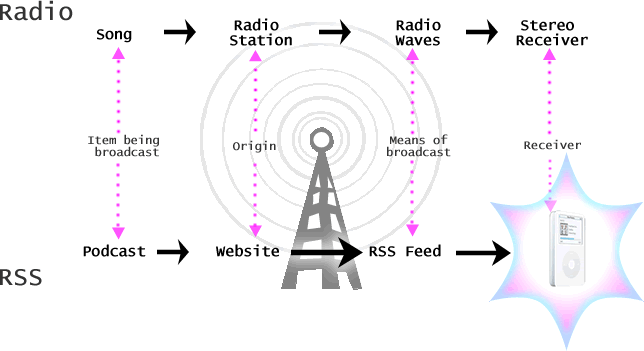
Podcasting has the extra feature of being portable as well as syndicate-able. How often do you guys see students walking around with white cords dangling out of their ears? A lot of our students (though, granted, not all) have ipods or other portable mp3 players. As we just saw, you certainly don't need an ipod to listen to a podcast - we just listened to one straight out of our browser and webct. But if a student has an ipod, then they can take their audio content anywhere they go.
Portability and syndication work together in podcasting. If a student has an iPod, then they are using the companion audio content management tool called iTunes. Using those tools, to subscribe to a podcast, a student would grab the RSS feed address for the podcast, and drop it into iTunes - from that point on, when a new podcast is added to that feed, it will automatically be downloaded onto her ipod whenever she plugs it in to charge/sync.
Instructional Applications
- GCSU and Elizabeth Hughes
- What's going on?!
- Music
- Verbal practice exercises
- News
- Recording herself
- Consuming and creating podcasts
The potential for applying podcasting to the classroom is huge. As an example, I want to play a 2-minute podcast from a student at Georgia State College and University.
play elizabeth hughes podcast
There are a few different things going on here - right? Elizabeth is
- listening to a spanish music podcast that her instructor has pointed her to
- listening to podcast conversations and filling in the blanks
- listening to spanish language news podcasts
- creating recordings of her own voice and podcasting those
That's two distinct ways that the instructor is using podcasts. He is using some that are already available - Spanish music and news. But he is also creating some podcasts, as well - the "fill in the blank" parts.
Consuming podcasts
- iTunes education podcasts
- Wide range of disciplines
- Review prior to use!
- News? Discipline specific?
Let's talk first about using podcasts that other people are creating. There are some great educational podcasts out there. The Insta Spanish? podcast I showed you earlier is just one example. There is a podcast called "Grammar Girl" that is described as "quick and dirty tips for better writing." That could probably benefit students of every discipline. A quick scan through the iTunes Education podcasts shows casts covering music and language, of course, but also science, photography, business, math, history, computing, and more. Will they all be appropriate to your course material? Who knows. You would, as with any resource, want to review it before using it. Since there is no way to know what's coming next with a podcast someone else is putting together, it might be a good idea to use them as supplemental material. For example, a lot of our poli sci or government instructors require students to read a newspaper on a regular basis. Tons of news agencies are podcasting regularly - why not incorporate that into an online classroom? Imagine having CNN Radio's news piped straight to your students classrooms or iPods! Ways to use this tool, will, of course depend on your classroom objectives, your discipline, etc, but they're limited only by your imagination!
Creating your own podcasts
- Lectures
- Guided tours?
- Makes review easier for the student (portability!)
Another approach, of course, is to create your own podcasts. Ruben is hammering out how we're going to facilitate the creation and storage of those files, but again, once we've got that piece taken care of, the possibilities are limitless. The most obvious use of podcasts is to create audio mirrors of your text-based lectures, or quick audio supplements. This would benefit students who are more inclined to be audio learners, and have the added benefit of being portable for those that do have portable devices - they could listen while driving to work, waiting between classes, running, etc.
Podcasting projects at other schools
- Stanford iTunes U project - http://itunes.stanford.edu
- UC Berkeley iTunes - http://itunes.berkeley.edu/
- Duke U - http://www.fuqua.duke.edu/itunes/
Central College podcast projects
- Central Podcast directory
- MyLife
- Digital Music Library (Donna Pinnick for professor Keith Caldwell)
Podcasting on a PC
- Audacity (freeware)
- Record from microphone input line
- Create multitrack recording
- Import WAV, AIFF, MP3s
- Export MP3s
- Volume fade in/out feature
- Built-in effects
- Easy to use
Podcasting on a Mac
- Garageband
- iLife 06 (comes with Macs)
- For Enhanced podcasting and slideshows
- Record from microphone input line
- Create multitrack recording
- Import WAV, AIFF, MP3s
- Export MP3s
- Built-in effects and sound library
- Easy to use
Going Mobile
- Placing podcast on an mp3 player
Thanks, and links
- iTunes : http://www.apple.com/itunes/
- Odeo : http://www.odeo.com
- Audacity : http://audacity.sourceforge.net/about/
- Podcast Alley : http://www.podcastalley.com
- iPodder : http://www.ipodder.org
- Juice : http://juicereceiver.sourceforge.net
- Podcasting News : http://www.podcastingnews.com
- Podcasting Tools : http://www.podcasting-tools.com